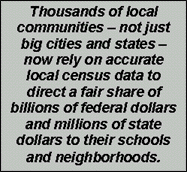
| |    Fairness Requires Local Accuracy In December 1998, Sacramento City Council member Lauren Hammond illustrated how fair and sensible distribution of federal funding relies on accurate local census numbers. Councilwoman Hammond testified to the Census Monitoring Board that the severe undercount in her district 13 – a predominantly African-American area – resulted in insufficient resources for a much-needed middle school. She testified that, although the 1990 census showed 46,000 people in her district, the actual population is closer to 60,000, and cited Bureau reports that children were severely undercounted in 1990.14

Councilwoman Hammond testified, "There might be some programs that need to be geared towards this particular ethnic group [African-Americans]. It is not reflected in the census, and the censuses are the only official numbers that we can use. ... I have four high schools and eight elementary schools and not one darn middle school because there aren't the numbers to reflect that. So a 2.9 percent undercount in Sacramento might seem insignificant. But many of them are children, are people who need more government resources than maybe perhaps other folks."15
Ms. Hammond’s missing middle school is not a constitutional problem (the Constitution does not require that census numbers be used to distribute funds), but it is a serious one. Over the years, additional uses of census numbers have grown enormously. Thousands of local communities – not just big cities and states – now rely on accurate local census data to direct a fair share of billions of federal dollars and millions of state dollars to their schools and neighborhoods.16 The Bureau has an obligation to ensure the most accurate numbers at the smallest levels of geography: neighborhoods and blocks.
Accurate block data also ensures the constitutional obligation of the census: fair political representation. Fair representation is fundamental to American government: every person’s vote counts. Voting districts — such as Congressional, state legislature, city council and school board districts — must represent equal numbers of people. The only way to ensure that they do is to use accurate local data on the population in each district.
Article I, section 2 of the Constitution mandates the decennial census, reading, "The actual enumeration shall be made within three years after the first meeting of the Congress of the United States, and within every subsequent term of ten years, in such manner as they shall by law direct."17
The Constitution also directs that the results of the census be used to apportion the Members of the House of Representatives among the States. Article I, section 2, reads, "Representatives … shall be apportioned among the several states … according to their respective numbers…" The 14th Amendment reads, "Representatives shall be apportioned among the several states according to their respective numbers, counting the whole number of persons in each State …"
In 1911, Congress fixed the number of U.S. Representatives at 435 – one per state and the rest apportioned. As a result, if one state gains a representative, another state must lose one. "In 1990, differences of fewer than 10,000 persons determined which states got the 434th and 435th seats (and which did not)."18
Drawing the districts that congressional seats represent – putting lines on a map – depends on knowing where people are within a state, so districts can be drawn around equal numbers of people, and each seat will represent an equal population. Locating people where they live is, therefore, essential.
Congressional districts are rarely uniform in size. Areas with denser populations have smaller congressional districts. Areas with sparse populations can be geographically huge. Montana and North Dakota, for instance, have only one congressional district each. California has 52. The more population recorded in an area, the more districts drawn in that area.
In the 1960’s the Supreme Court started a revolution in drawing districts: the concept of "one person, one vote." 19 The Court held that congressional districts within states must be equal "as nearly as practicable."20 For example, a hypothetical state with a population of ten million people – divided into ten congressional districts – should ideally have one million people in each district.
This standard has been reinforced repeatedly. In 1983, the Court found that even small, mathematically insignificant variances between districts can be objectionable.21 As a result of this ruling and the precision of computerized redistricting software, nearly all congressional districts drawn after the 1990 census were within a few dozen people of others in the state.22 This precision is only achievable by constructing districts at the block level.
The Bureau claims that block-level data is unnecessary for constructing districts, because districts actually contain many blocks. This claim ignores the fact that districts are drawn precisely, block-by-block, to ensure equal population and fair representation. It also ignores evidence that suggests blocks with high undercounts tend to cluster together. For instance, several adjacent blocks in inner-city Chicago will each tend to have high undercounts, and several adjacent blocks in the suburbs will each tend to have low undercounts. As a result, whole neighborhoods in the inner-city will tend to have higher undercounts than neighborhoods in the suburbs.23 If the inner city neighborhoods are placed in one congressional district and the suburban neighborhoods in another, the differential undercounts in these two areas will result in unfair representation.
The third legal point that ensures equal representation is the Voting Rights Act. The Act demands accurate block level data about race and ethnicity because it protects equal representation of minorities.
|
   |
|

